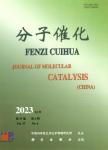ESCA STUDIES OF FORMIC AND ACETIC ACIDS ADSORPTION AND DECOMPOSITION ON PREOXIDISED IRON SURFACE
ESCA STUDIES OF FORMIC AND ACETIC ACIDS ADSORPTION AND DECOMPOSITION ON PREOXIDISED IRON SURFACE出 版 物:《分子催化》 (Journal of Molecular Catalysis(China))
年 卷 期:1990年第4卷第S1期
页 面:18-22页
核心收录:
学科分类:081704[工学-应用化学] 07[理学] 070304[理学-物理化学(含∶化学物理)] 08[工学] 0817[工学-化学工程与技术] 0703[理学-化学]
基 金:This work was financially supported by Academia Sinica (Young Scientists Research Award 1986)
主 题:SURFACE ESCA adsorbed attributed Roberts clearly exposed belongs acetic spectrometer
摘 要:XPS has been applied to study the interactions of formic and acetic acids with preoxidised iron surfaces. Exposure of the surface to acetic acid at 300 K would result in two Cls peaks of similar intensities at 285.2 eV and 289.0 eV B.E. (Binding Energy). An Ols component with FWHM about 2.2 eV was also observed at 532.0 eV B.E. It was suggested that CH3COOH adsorbed as CH3COO(a) and OH(a) on the surface according to surface acid-base interaction: CH3COOH(g)+O2-(a)(?) CH3COO(a)+OH(a) (1) The above mechanism was strongly supported stoichiometrically, using the Roberts—Carley equation for surface concentration calculations. When a preoxidised iron surface was exposed to formic acid at 300 K, two Cls peaks at 285.6 eV and 289.1 eV B.E. were clearly observed. The Cls peak at 289.1 eV B.E. was attributed to HCOO(a). Its formation mechanism also belongs to the kind of surface acid-base interaction: HCOOH(g)+O2-(a)(?)HCOO(a)+OH(a) (2) The other Cls peak at 285.6 eV was proposed to be CHxO(a). It



